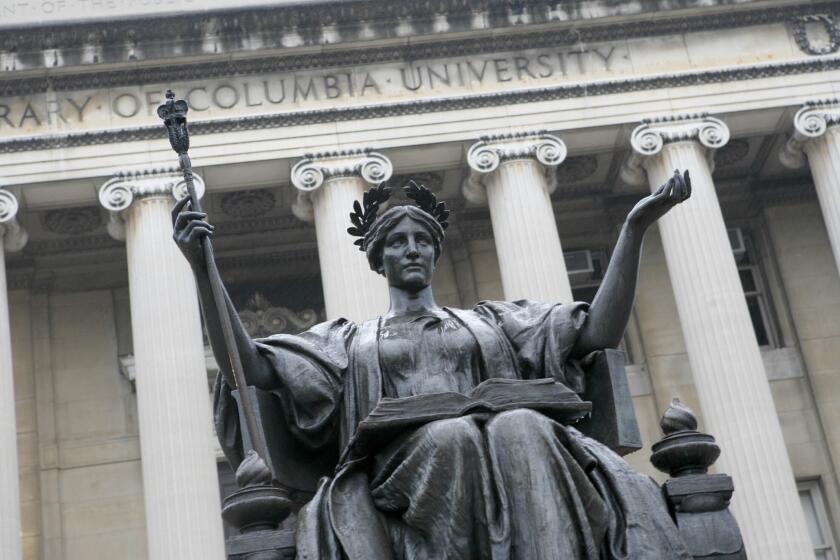Expatriate Oaxacans find a home for their saints in Santa Monica
The Santa Monica strip dotted with record studios and upscale condos looks nothing like the home they left behind. No fields abundant with agave. No central plaza. No prehistoric ruins.
Still, on a recent weekend Oaxacans traveled here from as far away as Washington and Utah to celebrate. They marched down Colorado Boulevard, blew their trumpets, balanced giant baskets of chrysanthemums on their heads and danced in gold brocade and velvet.
“We’re supposed to have fireworks, too, but the city’s safety code won’t allow it,” said Cindy Cruz, 26, as she followed the small procession.
Most of the celebrants can’t afford to live anywhere near Santa Monica. But after churches in other, more heavily Latino areas opposed their elaborate ways of praising, the indigenous community of the valley of Oaxaca, Mexico, found refuge here, at St. Anne’s Church and Shrine.
“They’ve allowed us to continue with our culture, to bring a little bit of our pueblo to life,” said Jacobo Hernandez Antonio, 42, who arrived from Oaxaca in the 1990s.
Over the last decade, groups from six Oaxacan villages have arrived at St. Anne’s door, one by one. Each village group has its own organized network, with its own representative and patron saint — depicted in ceramic statues caringly modeled after those in Oaxacan churches.
Over time, the village groups joined together to form a 30-piece band and to appoint a board of directors. And once a year, after months of saving, each group throws a giant bash in honor of its saint.
On this particular Sunday, close to 300 natives of one village, Santa Ana del Valle, gathered to pay its special tribute to St. Anne, the mother of the Virgin Mary, jumping ahead of the church’s own celebration, which occurs this weekend.
They carried a framed photograph of their statue past honking cars and curious passersby, then gathered for a Oaxacan Mass conducted in a mix of Spanish, English and Zapotec, their native language.
“We are here to ask for the entire town of Santa Ana del Valle,” Father Arturo Corral began. “We ask for peace, well-being and joy for everyone here and everyone back home.”
Early on, many of St. Anne’s parishioners hailed from Jalisco or Durango, Mexico. But starting in the 1960s, because of the bracero program, the modest church built for the Westside’s Spanish-speaking working class began to attract Oaxacans.
At that time, Santa Monica was more affordable and many Oaxacans lived in nearby apartments.
First, villagers from Tlacolula arrived with their patron, El Señor de Tlacolula (a black Jesus on a cross). Then in the 1990s came villagers from San Juan de la Villa with their saint, San Juan Bautista.
The numbers grew as word spread about Michael Gutierrez, St. Anne’s open-minded priest. Groups arrived from San Lucas Quiavini, San Miguel del Valle and even Oaxaca, the state’s capital.
This month, members of a new village, Gustavo Diaz Ordaz, began talks with church leaders about adding their saint, Santo Domingo, to the roster.
“There was a point where we just got inundated,” said Gutierrez, who moved to a Baldwin Park church a year ago after a decade at St. Anne’s. “We started taking them in, and it became clear to me that this was the future of the church.”
The Oaxacans have brought new life and new members to the 124-year-old church.
But churches elsewhere in the city have been far less inviting — rejecting the Oaxacans’ ways as too raucous, too far outside the Catholic mainstream.
“They didn’t understand our culture is huge and diverse,” said Hernandez Antonio, who regularly encourages his own children to follow the traditions of his village, Tlacolula. “They saw the celebrations, the dancers, the costumes, and saw it as something scandalous.”
The Oaxacans don’t always make acceptance easy. They come in self-contained units that want to do things their way.
Village groups arrive with their own mayordomo, a leader chosen annually to represent their village. The mayordomo must find ways to pay for the annual saint’s celebration, which can last up to a week and can cost up to $30,000. The tradition dates to colonial times and, back home, starts with chiming bells and the bang of fireworks and ends with a community dance. It also includes lots of mezcal, an alcohol made from agave, which is one of the customs that L.A. priests have frowned on.
Most of St. Anne’s Oaxacans work in the service industry, as cooks, busboys and housekeepers. Saving for the feasts is a major part of their lives.
The challenge for St. Anne’s has always been to encourage the Oaxacans to stick around after the celebrations — to become part of the overall church, to give money to it, to attend Mass, Bible classes and catechism courses.
“They tend to have their party and then they leave and you don’t see them until next year,” said Deacon Raul Molina.
To try to change that, Gutierrez added a Oaxacan Mass to the church’s offerings. He encouraged the Oaxacans to organize the service and bring in their own brass band.
The Oaxacan influence is immediately felt as you enter the parish. The northwest corner of the church is reserved for their saints. Against the wall, the statues stand in a line inside glass cases, their feet adorned not with candles but with white and orange gladioluses as Oaxacans prefer.
At Santa Ana del Valle’s celebration, St. Anne’s new priest, Corral, looked on as villagers filled the church’s courtyard with their celebration. In one corner, women sold Oaxacan ice cream and sweet baked bread. Nearby, clayudas — thin, crunchy tortillas — were being piled high with beans, cabbage, Oaxacan cheese and shredded chicken.
And in the center, Jose Luis Garcia made the crowd laugh as he charged a fellow parishioner while holding over his head a fake bull fashioned out of fabric and scraps of plywood. It was one of many events lined up for the day.
“Just like the Italians and Germans once came looking for places to express their faith together, so are the Oaxacans,” said Corral, who grew up in Durango and arrived at St. Anne’s a year ago. “I think it’s a very human process for all cultures.”
esmeralda.bermudez@latimes.com
More to Read
Start your day right
Sign up for Essential California for news, features and recommendations from the L.A. Times and beyond in your inbox six days a week.
You may occasionally receive promotional content from the Los Angeles Times.







